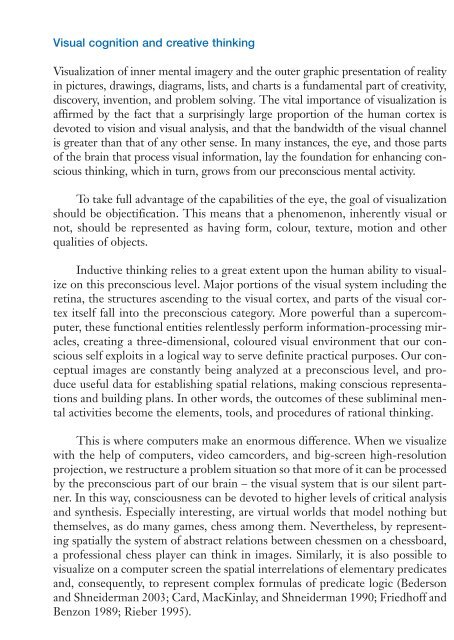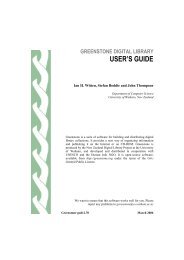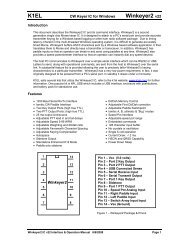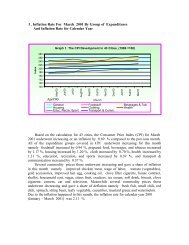Information and communication technologies in schools: a ...
Information and communication technologies in schools: a ...
Information and communication technologies in schools: a ...
Create successful ePaper yourself
Turn your PDF publications into a flip-book with our unique Google optimized e-Paper software.
112<br />
ICT IN SCHOOLS<br />
A HANDBOOK FOR TEACHERS<br />
Visual cognition <strong>and</strong> creative th<strong>in</strong>k<strong>in</strong>g<br />
Visualization of <strong>in</strong>ner mental imagery <strong>and</strong> the outer graphic presentation of reality<br />
<strong>in</strong> pictures, draw<strong>in</strong>gs, diagrams, lists, <strong>and</strong> charts is a fundamental part of creativity,<br />
discovery, <strong>in</strong>vention, <strong>and</strong> problem solv<strong>in</strong>g. The vital importance of visualization is<br />
affirmed by the fact that a surpris<strong>in</strong>gly large proportion of the human cortex is<br />
devoted to vision <strong>and</strong> visual analysis, <strong>and</strong> that the b<strong>and</strong>width of the visual channel<br />
is greater than that of any other sense. In many <strong>in</strong>stances, the eye, <strong>and</strong> those parts<br />
of the bra<strong>in</strong> that process visual <strong>in</strong>formation, lay the foundation for enhanc<strong>in</strong>g conscious<br />
th<strong>in</strong>k<strong>in</strong>g, which <strong>in</strong> turn, grows from our preconscious mental activity.<br />
To take full advantage of the capabilities of the eye, the goal of visualization<br />
should be objectification. This means that a phenomenon, <strong>in</strong>herently visual or<br />
not, should be represented as hav<strong>in</strong>g form, colour, texture, motion <strong>and</strong> other<br />
qualities of objects.<br />
Inductive th<strong>in</strong>k<strong>in</strong>g relies to a great extent upon the human ability to visualize<br />
on this preconscious level. Major portions of the visual system <strong>in</strong>clud<strong>in</strong>g the<br />
ret<strong>in</strong>a, the structures ascend<strong>in</strong>g to the visual cortex, <strong>and</strong> parts of the visual cortex<br />
itself fall <strong>in</strong>to the preconscious category. More powerful than a supercomputer,<br />
these functional entities relentlessly perform <strong>in</strong>formation-process<strong>in</strong>g miracles,<br />
creat<strong>in</strong>g a three-dimensional, coloured visual environment that our conscious<br />
self exploits <strong>in</strong> a logical way to serve def<strong>in</strong>ite practical purposes. Our conceptual<br />
images are constantly be<strong>in</strong>g analyzed at a preconscious level, <strong>and</strong> produce<br />
useful data for establish<strong>in</strong>g spatial relations, mak<strong>in</strong>g conscious representations<br />
<strong>and</strong> build<strong>in</strong>g plans. In other words, the outcomes of these sublim<strong>in</strong>al mental<br />
activities become the elements, tools, <strong>and</strong> procedures of rational th<strong>in</strong>k<strong>in</strong>g.<br />
This is where computers make an enormous difference. When we visualize<br />
with the help of computers, video camcorders, <strong>and</strong> big-screen high-resolution<br />
projection, we restructure a problem situation so that more of it can be processed<br />
by the preconscious part of our bra<strong>in</strong> – the visual system that is our silent partner.<br />
In this way, consciousness can be devoted to higher levels of critical analysis<br />
<strong>and</strong> synthesis. Especially <strong>in</strong>terest<strong>in</strong>g, are virtual worlds that model noth<strong>in</strong>g but<br />
themselves, as do many games, chess among them. Nevertheless, by represent<strong>in</strong>g<br />
spatially the system of abstract relations between chessmen on a chessboard,<br />
a professional chess player can th<strong>in</strong>k <strong>in</strong> images. Similarly, it is also possible to<br />
visualize on a computer screen the spatial <strong>in</strong>terrelations of elementary predicates<br />
<strong>and</strong>, consequently, to represent complex formulas of predicate logic (Bederson<br />
<strong>and</strong> Shneiderman 2003; Card, MacK<strong>in</strong>lay, <strong>and</strong> Shneiderman 1990; Friedhoff <strong>and</strong><br />
Benzon 1989; Rieber 1995).
















